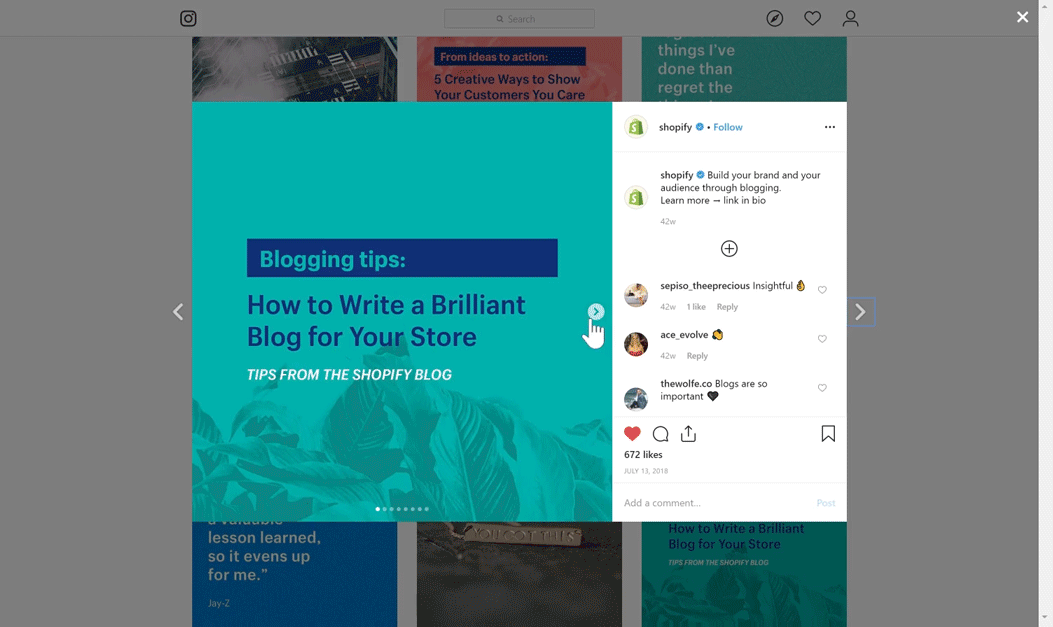With the rise of social media, many people may think that blogs have gone out of fashion.
Even though social media can be good for a variety of things – such as building brand awareness and introduce customers to new products – having a blog is a necessary tool for your online store.
The benefits to having a blog are huge: it is one of the best ways for you as an ecommerce business to engage with your audience, and it can improve your SEO, which in turn helps to boost your Google ranking (and traffic!).
So whether you offer selling products to businesses or consumers, here’s how a blog can help take your online store to the next level.
Connect with your audience
First of all, having a blog is a great way for you to engage with your audience.
It allows you to tell your customers about what you value as a brand and makes you stand out from the competition.
Your blog can be a great resource for customers to turn to for industry advice or maybe something a little more fun.
Don’t worry about your niche, a blog can work for any type of ecommerce business or online store.
If you sell second-hand clothes, you could blog about how to repair your favorite pair of jeans or how to recreate looks from the latest Spring drop.
If you’re a food retailer, your blog could list the best movie snacks of all time and give a healthy alternative.
By creating engaging content, your blog will be something that your audience looks forward to reading on the commute to work or during a coffee break – as well as giving providing them with useful information.
But be warned: a blog that sounds like a sales pitch is likely to have the opposite effect and turn customers off.
Top tip: Listen to the data. If you find that some of your blog posts are more popular than others, then focus on posting more of that type of information.
Raise your hand if you’ve got a question: Provide helpful customer advice
Having a blog allows you to position yourself as a thought leader in your industry, where you can show your customers that you know what you’re talking about.
This can help generate customer trust.
When Pixc launched in 2014, I would get a lot of questions from new online retailers such as, “what kind of images do I need for my store?” or “how can I make my store look more professional?” – Business owners needed help when launching an online store, and didn’t know where to turn.
But instead of referring them to a boring FAQ, the Pixc blog lets me deep-dive into a subject and use screenshots and images to illustrate my points (just like this one!).
Top tip: Look at the types of questions that you always get from customers and make it a blog topic – there is a good chance other customers have the same question but are afraid to ask!
When you receive the same question next time, you can redirect them to the blog post.
Get visible: A blog helps boost your SEO
If you want your website to have a good Google page ranking, you should have a blog.
Search Engine Optimisation (SEO) helps to determine Google page rankings, so many people hire SEO experts to optimize their website.
But a blog is an easy way to improve your website’s SEO for three simple reasons:
- By creating blog content that has a clear call to action – i.e. how you can use this product or how this product can benefit your life – you can backlink to product pages or other content on your website.
- Creating shareable content will mean that other people will link back to your page increasing traffic to your website and potentially helping you to build regular visitors to the site.
- Posting regularly on your blog indicates that you keep your website’s content up to date and relevant.
Top tip: Having better SEO will also help drive organic traffic back to your online store, so you’re not relying on paid acquisition channels to gain customers.
Blog posts are great content for social media
You can easily convert your blogs into posts for social media which can amplify your message by introducing a wider audience to your content and thereby drive more traffic to your website.
A great example is Shopify’s engaging and informative infographic photo stream on Instagram:

Video is another great way to share your content on social media. Lumen5 is the perfect tool to which turns text into engaging videos built for social media.
Videos can be tailored to match your brand style – and best of all, they take minutes to make!
Top tip: Whatever content you create, you should share it across your social media channels – LinkedIn, Facebook, Instagram, Twitter, etc.
Amplifying your brand: The unexpected benefits of having a blog
Maintaining a blog can be a lot of work. You need to source and write content, promote it, and come up with new ideas on a regular basis.
But, it can also lead to unexpected positive outcomes for both your online store and personal brand.
For example, the Pixc blog has given me the opportunity to speak on panels and get interviewed by industry media channels about ecommerce and remote work.
Also, a CEO from one of the largest ecommerce platforms recently reached out to me to write a guest blog for their website.
This helps us gain exposure to another audience and show them that they can trust me and what I have to say is legitimate, which in turn drives more traffic back to the Pixc website.
Top tip: A blog gives you the opportunity to network and grow your business by showing your audience that you are an expert in your field.
The nitty-gritty: How to launch a successful blog for your online store
Now that you know why having a blog, how do you start one? Here are some guidelines for a successful blog:
- Set a goal
Some people might think a successful blog means reaching a certain number of readers whereas others might want to increase revenue by 10% over six months from blog launch. Define what success means to you and work to achieve it. - Write for your ideal persona/shopper
Identify the type of customer that you want to reach and write the content for them. - Write in a friendly and engaging style
If you share advice, it sounds better coming from a friend rather than a company. Instead of saying “according to one survey, 45% of women have dry hair”, try something like, “this is how women can tackle dry hair.” - Set clear content guidelines
Lay out the dos and don’ts for your blog and stick to them. - Post consistently
Start slowly and then publish more frequently once you get into the habit of writing. Ideally, you should aim to publish one new blog a week, but one a month is fine too – whatever works for your schedule, just make sure it is consistent! People will keep checking back and it will let them know that your website is being kept up-to-date. - Have consistent imagery
Make sure to have consistent images. It is something that a lot of people overlook is keeping images consistent. This will also help with your branding. - Readability
Formatting your own HTML can be inconsistent if you don’t actively put in the correct heading, paragraphing, etc. Even simple things such as keeping the paragraph width and height consistent can make your blog look less messy; the small details matter. - Include the authors’ bylines
By including the name of the author and a short bio on a blog article makes it feel more personal and trustworthy, which will help the reader connect with the content.
Top tip: Come up with a few ideas ahead of time. Try to stay a few steps ahead of content.
Ideally, you have about two weeks worth of articles ready to publish because there will inevitably be some reason that you are unable to write an article each week, meaning your audience has to wait.
Get creative: When a blog isn’t a blog
Despite being an invaluable tool, starting a blog can seem like a daunting task – maybe you think that you are a bad writer or you just don’t have the time.
But a blog doesn’t just have to be written text; it can be done in any medium you want as long as it meets your customers’ needs.
Here are some ideas of different types of blogs to get you started:
- Short posts about how to use or style a product
- A step-by-step picture guide on using an item
- Podcasts interviewing customers or suppliers
- Monthly topical Ask Me Anything (AMAs)
- Video tutorials and how-to’s
Ultimately, there is no “right way” to do a blog so keep experimenting until you find what works best for your online store and your brand.
And remember, you can always check the Pixc blog for more ideas!








